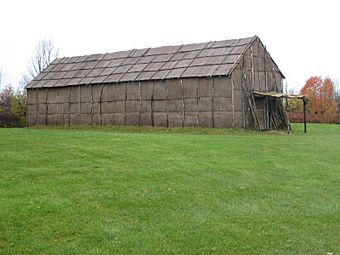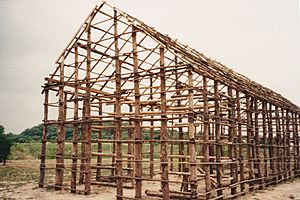Ganondagan State Historic Site facts for kids
|
Boughton Hill
|
|

Ganondagan Long House
|
|
| Location | Victor, NY |
|---|---|
| Built | 1670 |
| NRHP reference No. | 66000559 |
Quick facts for kids Significant dates |
|
| Added to NRHP | October 15, 1966 |
| Designated NHL | July 19, 1964 |
Ganondagan State Historic Site (pronounced ga·NON·da·gan), also known as Boughton Hill, is an important Native American historic site. It is located in Ontario County, New York, in the Town of Victor. This site was once the largest Seneca village in the 1600s. The village was also called by names like Gannagaro and Canagora.
The site has two main parts. The Boughton Hill area covers about 245 acres. This is where the Seneca longhouses and burial grounds were. It is recognized as a National Historic Landmark. The other part, Fort Hill, is 33 acres. It was a fortified place to store grain. This area is listed on the National Register of Historic Places. The state of New York manages and operates this historic site.
Contents
History of Ganondagan
Seneca Life and Traditions
The Seneca people, like many other Native American groups, grew important crops. They called these the "Three Sisters": corn, beans, and squash. Seneca women were skilled farmers. They grew different types of each crop. These plants were often grown together. Beans could climb the tall cornstalks. The large squash leaves helped keep weeds away.
Ganondagan was the biggest town of the Seneca nation. The Seneca were known as the "western gateway" of the Haudenosaunee (Iroquois Confederacy). This site is central to the story of the Peacemaker. He brought five major peoples together to form the Haudenosaunee confederacy. This confederacy still exists today.
Seneca stories tell of a Huron man who came to the Mohawk people. He spoke about the Gayanesshagowa, or the Great Law of Peace. This leader is known as The Great Peacemaker. The Mohawk, Oneida, and Cayuga agreed to join his confederation. After some important discussions, the Seneca also agreed.
A key meeting happened in the Ganondagan home of Jikonsase. She was a wise Seneca woman elder, now called the "Mother of Nations." She suggested a way to include the Onondaga people. Her idea gave them an important role in the confederacy. Jikonsase lived near Ganondagan and is buried there.
Because of this story, the Seneca call Ganondagan the "Town of Peace." They deeply respect and protect Jikonsase's burial site. The Great Law of Peace is very important to them. It shows how they find solutions through discussion. The United States Senate recognized the Iroquois Confederacy's ideas. They noted its influence on the U.S. Constitution in 1988.
Early European Encounters
In 1656, a Jesuit priest named Father Pierre-Joseph-Marie Chaumonot visited the Seneca nation. He met with the elders of Ganondagan. He shared Christian teachings and offered gifts to show friendship. By 1668, Jesuits had missions in all five Iroquois nations. Father James Fremin was assigned to the Seneca's Mission of St. Jacques. However, tensions grew with the French. The Seneca asked the missionaries to leave in 1684.
In 1669, René-Robert Cavelier, Sieur de La Salle, and Father René de Bréhant de Galinée traveled to Ganondagan. They arrived via Irondequoit. Galinée described the village as many cabins. These were surrounded by tall wooden fences called palisades. He noted that these forts were not very strong.
In 1677, Wentworth Greenhalgh, an English official, visited the Iroquois nations. He wanted them to become allies with the British. He stopped at Ganondagan, calling it Canagora. He wrote that the village was on a big hill and had about 150 houses. He also mentioned that the Seneca people were very welcoming. He observed some difficult events involving prisoners during his visit.
Later, in 1678, René-Robert Cavelier, Sieur de La Salle, and Father Louis Hennepin visited Ganondagan. Hennepin called it Tagorondies. He saw Jesuit priests Julien Garnier and Pierre Raffeix there. He also noted a small chapel made of tree bark. Hennepin described the Seneca people as tall and well-built. He said they wore robes of animal skins. He felt they spoke with great wisdom and dignity.
The Destruction of Ganondagan
In 1687, the Marquis de Denonville led a large French army from Canada. His goal was to remove the Seneca as rivals in the fur trade. The Seneca were trading with the English, and the French wanted to control this valuable trade. This conflict was part of the Beaver Wars. During these wars, different Native American tribes also fought for power in the fur trade.
On July 13, 1687, the French army approached Ganondagan. A Seneca force of 800 people attacked them. After a short fight, the Seneca retreated. Denonville reported that the French had few casualties. A British report, based on Seneca accounts, said the Seneca force was smaller. It included many young men and some women.
The British report also stated that most villagers had already moved to safety. They had gone to Cajouge (Cayuga) or a lake to the south. The Seneca themselves set fire to their own villages. When the French arrived on July 14, they found Ganondagan burned. A nearby fort was also empty. The French destroyed huge amounts of corn. They visited four Seneca villages and ruined 1.2 million bushels of corn. They then destroyed the village of Totiakton before returning to their boats.
After this battle, the Seneca communities moved eastward. The villages of Gandagora and Gandougarae joined this move. They settled first at Canandaigua and later near Canandaigua Lake. During the American Revolutionary War, the Sullivan Expedition in 1779 attacked Seneca towns again. These were located near Geneva, Canandaigua, and along Seneca Lake (New York).
Ganondagan Today
For over a hundred years after the American Revolutionary War, the Seneca used this land for farming. In the 1930s, Chief Freeman Johnson worked to protect the property. He wanted to stop people from stealing valuable artifacts. In 1964, Boughton Hill became a National Historic Landmark. The state historic park was officially created in 1987.
The Seneca people have made many important contributions to the United States. Their political ideas influenced the U.S. Constitution. The Seneca had a matrilineal kinship system. This meant that inheritance and property passed through the mother's family line. Children belonged to their mother's family and clan. This gave women significant power. In 1848, American women met at Seneca Falls, New York. They created a declaration of rights to gain similar power. Women finally received the right to vote in 1920.
Today, Ganondagan is the site of a major 17th-century Seneca village. It features a rebuilt Seneca longhouse and a small visitor center. The original town covered about nine acres. It had homes, storage areas, fields, and places for animals. There were nearly 150 longhouses and burial grounds. The village was surrounded by large corn fields. A strong granary was at the Fort Hill site. Ganondagan was known as the "breadbasket" for the Haudenosaunee. The Seneca supplied much corn to the confederacy.
The park includes miles of trails across more than 560 acres. The Friends of Ganondagan work to preserve the land. They also help keep Seneca cultural traditions alive.
See also




